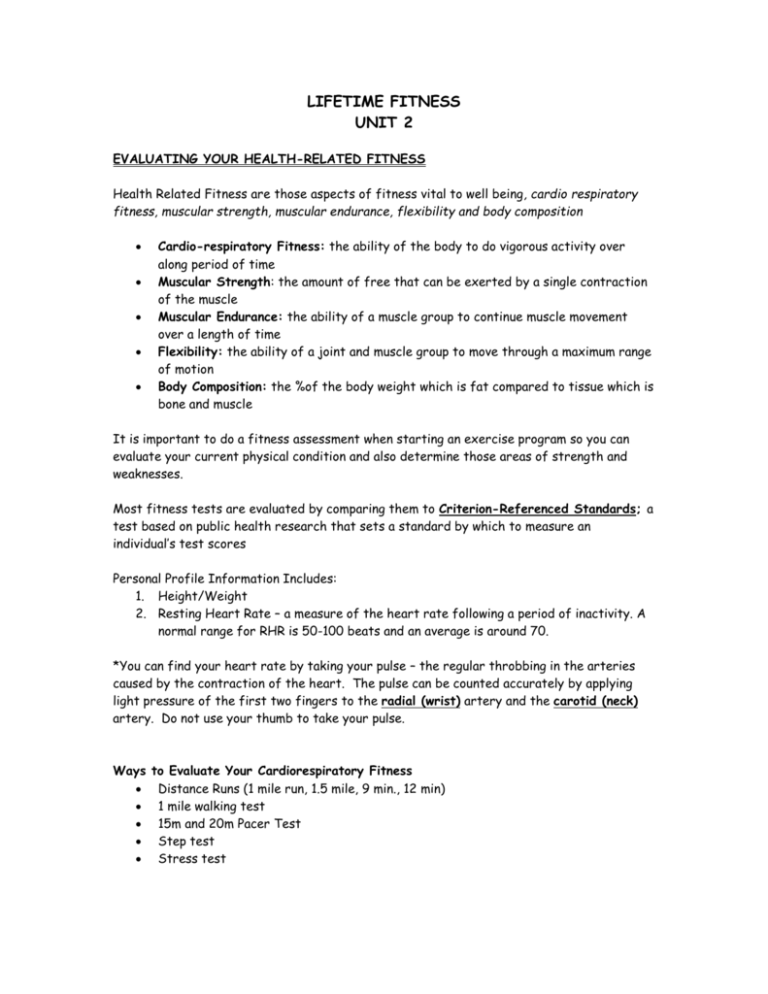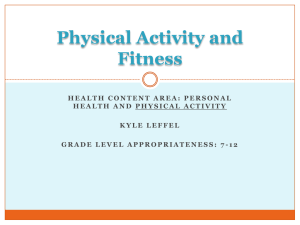Unit 2 Notes - Brookwood High School
advertisement

LIFETIME FITNESS UNIT 2 EVALUATING YOUR HEALTH-RELATED FITNESS Health Related Fitness are those aspects of fitness vital to well being, cardio respiratory fitness, muscular strength, muscular endurance, flexibility and body composition Cardio-respiratory Fitness: the ability of the body to do vigorous activity over along period of time Muscular Strength: the amount of free that can be exerted by a single contraction of the muscle Muscular Endurance: the ability of a muscle group to continue muscle movement over a length of time Flexibility: the ability of a joint and muscle group to move through a maximum range of motion Body Composition: the %of the body weight which is fat compared to tissue which is bone and muscle It is important to do a fitness assessment when starting an exercise program so you can evaluate your current physical condition and also determine those areas of strength and weaknesses. Most fitness tests are evaluated by comparing them to Criterion-Referenced Standards; a test based on public health research that sets a standard by which to measure an individual’s test scores Personal Profile Information Includes: 1. Height/Weight 2. Resting Heart Rate – a measure of the heart rate following a period of inactivity. A normal range for RHR is 50-100 beats and an average is around 70. *You can find your heart rate by taking your pulse – the regular throbbing in the arteries caused by the contraction of the heart. The pulse can be counted accurately by applying light pressure of the first two fingers to the radial (wrist) artery and the carotid (neck) artery. Do not use your thumb to take your pulse. Ways to Evaluate Your Cardiorespiratory Fitness Distance Runs (1 mile run, 1.5 mile, 9 min., 12 min) 1 mile walking test 15m and 20m Pacer Test Step test Stress test A Joint is a place where two or more bones meet and from a junction in the body. Joints may be immovable (such as those in the skull) or moveable (such as those in the elbow, hip, shoulder and neck). Flexibility requires you to use a joint to its fullest. No single test can measure flexibility since it is specific to each join and muscle group. Ways to evaluate your Flexibility Fitness Back-saver sit and reach test (hamstring muscle) Trunk lift (upper back and trunk) Shoulder stretch test (upper body/shoulders) Lean body weight (muscle mass) is that body weight composed of muscle bone, tendons, ligaments, and internal organs. Fat weight is weight which is not muscle, bone, tendons, ligaments or internal organs. Body Composition is the percent of the body weight which is fat compared to tissue which is bone and muscle. Ways to determine your Body Composition Underwater weighing (most accurate) Bioelectrical impedance unit Skinfold measurement Body Mass Index (BMI) Ways to evaluate your Muscular Strength and Endurance Curl-up (abdominal muscles) Pull up (arm and shoulder muscles) Flexed arm hang (arm and shoulder muscles) Push-up (arm and shoulder area) Gwinnett County uses FitnessGram. Below you will find your standards for your age. FitnessGram Healthy Zone Standards Aerobic Capacity and Body Mass Index instructions Aerobic Capacity Look up Tables for Boys and Girls 14 to 15 Aerobic Capacity Look up Tables for Boys and Girls 16 to 17 2004 FitnessGram Standards for Healthy Fitness Zone TRAINING for FITNESS Training is the procedure of systematically preparing a person in the most efficient manner to perform strenuous activity and to recover from that activity as quickly as possible. Certain basic principles determine the effectiveness of a training program. **PRINCIPLES OF TRAINING** Overload Progression Specificity OVERLOAD occurs when increased demands are made upon the body. The increased stress causes the body to adapt or adjust improving physical condition. Three ways to overload the body through exercise Frequency – increasing how often you exercise 2. Intensity – increasing the difficulty of an exercise 3. Time – increasing the length of each training session 1. PROGRESSION is the gradual increase in exercise or activity over a period of time SPECIFICITY refers to the fact that improvements in the various fitness areas require specific kinds of activities Training Guidelines Cardiorespiratory Fitness F 3-5 days per week I 60-80% maximum heart rate T 15-60 minutes of continuous activity Flexibility F At least 3 times per week I Slow stretch until mild tension is felt T Hold each stretch 15-30 seconds Muscular Strength F 2-4 times per week I high resistance T 8-12 repetitions Muscular Endurance F 3 days per week I low resistance T 12-20 repetitions Remember to properly warm up to prepare your body for exercise and decrease you chance of injury. Warm-up should last 10 to 15 minutes. Three parts to a good warm-up include: Large muscle warm-up (slow jogging) Static Stretching Specific activity that is similar to the workout that you are able to start Cool down is also important. It is the tapering off period after completing the conditioning phase of training. It enables the body to adjust slowly to reduced activity, prevents muscle cramps and soreness and prevents blood pooling. There are 2 parts to a cool down: Continue activity at a slow pace Stretching exercises should be performed to prevent muscle soreness and loosen tight muscles. Other Training Factors Plateau – a period in training where your performance shows no improvement for a period of time Rate of Response – each person responds differently to a particular training program. Possible reasons include current condition, heredity, age, motivation, athletic ability, body type, weight, nutrition, injury proneness, lack of disease Overtraining – when a person participates in any physical activity at very high intensity levels or for unusually long periods of time…exercising too much! Cross-training – combining two or more types of exercise in one workout or using different exercises alternately in successive workouts….helps to prevent boredom and also allows for you to train through an injury Other Factors to Consider before starting an Exercise Program Previous involvement in physical activity Present Fitness level Present Health Medical History Exercise Training Myths No Pain, No gain I can get fit by participating in a sport A little exercise doesn’t help






